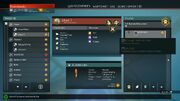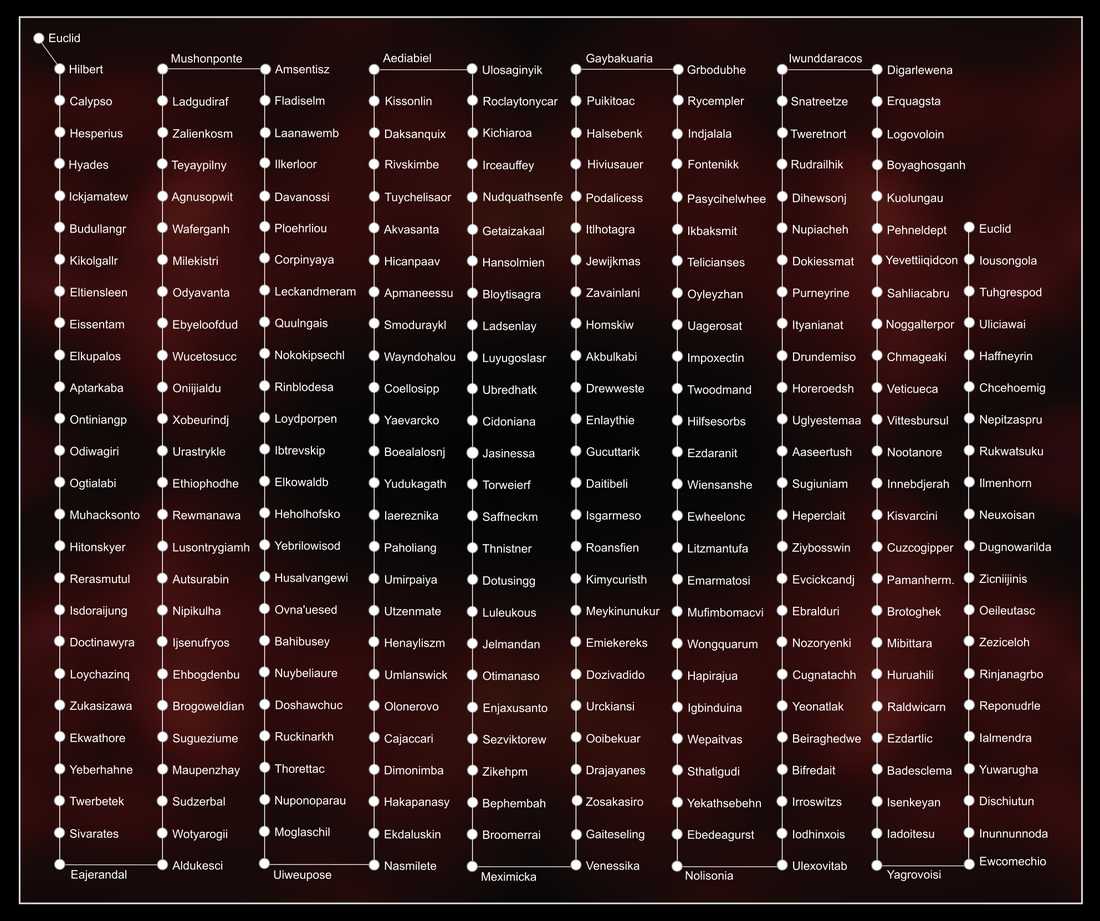Tags: Mobile edit Mobile web edit |
mNo edit summary |
||
| Line 75: | Line 75: | ||
* [[Oniijialdu|43 Oniijialdu]] |
* [[Oniijialdu|43 Oniijialdu]] |
||
* [[Wucetosucc|44 Wucetosucc]] |
* [[Wucetosucc|44 Wucetosucc]] |
||
| − | * [[ |
+ | * [[Ebyeloof|45 Ebyeloof]] |
* [[Odyavanta|46 Odyavanta]] |
* [[Odyavanta|46 Odyavanta]] |
||
* [[Milekistri|47 Milekistri]] |
* [[Milekistri|47 Milekistri]] |
||
| Line 306: | Line 306: | ||
===Historic galaxies=== |
===Historic galaxies=== |
||
{{cols|1| |
{{cols|1| |
||
| + | * [[Ebyeloofdud|45 Ebyeloofdud]] - It was renamed to '''Ebyeloof'''. |
||
* [[Odyalutai|256 Odyalutai]] - It does not allow travel to Yilsrussimil (257), but to Hilbert Dimension (2). |
* [[Odyalutai|256 Odyalutai]] - It does not allow travel to Yilsrussimil (257), but to Hilbert Dimension (2). |
||
* [[Yilsrussimil|257 Yilsrussimil]] - It does not allow travel to the 258th galaxy, but to Calypso (3). |
* [[Yilsrussimil|257 Yilsrussimil]] - It does not allow travel to the 258th galaxy, but to Calypso (3). |
||
Revision as of 15:53, 8 August 2019
| The subject of this article is from the Visions update.
The information from this article is up-to-date as of 13 August, 2019. |
The information from this article is up-to-date as of 13 August, 2019.

| This article is about the Visions version of the Galaxy page. For the Atlas Rises version, see Galaxy (Atlas). |
A galaxy is the second largest named object in No Man's Sky.
Summary
The universe of No Man's Sky comprises 255 unique galaxies, which in turn comprise around 3 to 4 billion regions, each of which contain more than 122 and up to hundreds of star systems. All star systems feature from 1-6 planets and moons, and usually a single space station.
Players start in galaxy 1, Euclid, and travel through galaxies in order by reaching the Galaxy Centre or jump several by finishing the New Beginnings primary mission. After the player leaves galaxy 255 (Iousongola), they return to the first galaxy again.
There are several methods of moving to a different galaxy, and various hazards and damages will occur during the transfer.
Galaxy types

Galaxy choice in New Beginnings mission
There are four types of galaxies:
- Empty - This type is referred to in-game as Ancestral, Frozen, Exhausted or Silent galaxy, and displayed with a blue hologram.
The following numbered galaxies belong to this type: 7, 12, 27, 32, 47, 52, 67 etc, a total of 26. [1] - Harsh - This type is referred to in-game as Burning, Raging, Relentless or Ruthless galaxy, and displayed with a red hologram.
The following numbered galaxies belong to this type: 3, 15, 23, 35, 43, 55, 63 etc, a total of 26. - Lush - This type is referred to in-game as Halcyon, Inspiring, Serene or Tranquil galaxy, and displayed with a green hologram.
The following numbered galaxies belong to this type: 10, 19, 30, 39, 50, 59, 70 etc, a total of 25. - Norm - This type is referred to in-game as Imperfect, Improved, Parallel or Rebuilt galaxy, and displayed with a teal hologram.
The majority of the galaxies belong to this type, a total of 178.
Biome probabilities

Likast 1 has Wire Cell type Exotic biome and located in a yellow star system (Visions)
When visiting a certain galaxy type, the probabilities of discovering various planet biomes are as follows. Meaning of the line "All" is not yet known, but the most likely explanation is that the probabilities for Biome types of these colored stars (Red, Green, & Blue) do not change based on Galaxy type.
Due to the harsh galaxy missing, the speculation is that this galaxy type is like the norm galaxy, but with more storms.
The values in the table could be interpreted as per the following:
- 4 - Very high chance
- 3 - High chance
- 2 - Normal chance
- 1 - Low chance
- 0 - Very low chance
Normal planets
This is the table for normal planet probability:
| System colours | Yellow | Red | Green | Blue | ||
|---|---|---|---|---|---|---|
Galaxy |
Norm | Lush | Empty | All | ||
| Lush | 2 | 4 | 1 | 1 | 1 | 1 |
| Toxic | 1 | 1 | 1 | 1 | 1 | 1 |
| Scorched | 1 | 1 | 1 | 1 | 1 | 1 |
| Radioactive | 1 | 1 | 1 | 1 | 1 | 1 |
| Frozen | 1 | 1 | 1 | 1 | 1 | 1 |
| Barren | 1 | 1 | 1 | 1 | 1 | 1 |
| Dead | 2 | 0.5 | 4 | 2 | 2 | 2 |
| Weird | 0 | 1 | 1 | 3 | 1 | 2 |
| Red | 0 | 0 | 0 | 1 | 0 | 0 |
| Green | 0 | 0 | 0 | 0 | 1 | 0 |
| Blue | 0 | 0 | 0 | 0 | 0 | 1 |
| Swamp | 0 | 0 | 0 | 0 | 0 | 0 |
| Lava | 0 | 0 | 0 | 0 | 0 | 0 |
| All | 0 | 0 | 0 | 0 | 0 | 0 |
Prime planets
This is the table for prime planets, the planets that have been added with Origins:
| System colours | Yellow | Red | Green | Blue | ||
|---|---|---|---|---|---|---|
Galaxy Biome |
Norm | Lush | Empty | All | ||
| Lush | 2 | 4 | 1 | 1 | 1 | 1 |
| Toxic | 0.5 | 0.5 | 0.5 | 1 | 1 | 0.5 |
| Scorched | 1 | 1 | 1 | 1 | 1 | 1 |
| Radioactive | 0.5 | 0.5 | 0.5 | 0.5 | 0.5 | 0.5 |
| Frozen | 1 | 1 | 1 | 1 | 1 | 1 |
| Barren | 1 | 1 | 1 | 1 | 1 | 1 |
| Dead | 0.5 | 0.5 | 0.5 | 0.5 | 0.5 | 0.5 |
| Weird | 0 | 0.5 | 0 | 0.5 | 0.5 | 0.5 |
| Red | 0 | 1 | 1 | 3 | 0 | 0 |
| Green | 0 | 1 | 1 | 0 | 3 | 0 |
| Blue | 0 | 1 | 1 | 0 | 0 | 3 |
| Swamp | 1 | 1 | 1 | 0 | 2 | 1 |
| Lava | 1 | 1 | 1 | 2 | 0 | 1 |
| All | 0 | 0 | 0 | 0 | 0 | 0 |
Convert Dead To Weird
Convert Dead To Weird is a property with a value of 0.5.
It was added in the Visions update that introduced new Weird (Exotic) biomes by converting previously existing Dead biomes.
Due to this change there is a higher chance to find these biomes, even in yellow star systems as well.
Naming conventions
The first handful of names are not as whimsically chosen as they look. Euclid was an early Greek mathematician who defined some of the basic mathematical rules for defining two dimensional shapes in both 2D and 3D space. This is followed by the Hilbert Dimension; Hilbert space is a mathematical framework for certain types of finite- or infinite-dimensional vector spaces that are central in for example quantum mechanics.
Next up, Calypso breaks from the mathematical/spacial references but is still related. Calypso is a mythological figure, which lured Odysseus from his path on the Odyssey and held him captive for seven years., Hesperius and Hyades are all names/terms that refers to the daughters of Atlas in Greek mythology. Beyond that point, the galaxies appear to have a similar naming scheme to the randomly generated planet names and are likely using the same generator.
Known positive galaxies
The intent of the following list is to not only show a list of known galaxies, but to indicate the order in which they are visited by the player. When adding new galaxies, be sure to place them in the correct spot in the list.
Galaxies 1-50
- 1 Euclid
- 2 Hilbert Dimension
- 3 Calypso
- 4 Hesperius Dimension
- 5 Hyades
- 6 Ickjamatew
- 7 Budullangr
- 8 Kikolgallr
- 9 Eltiensleen
- 10 Eissentam
- 11 Elkupalos
- 12 Aptarkaba
- 13 Ontiniangp
- 14 Odiwagiri
- 15 Ogtialabi
- 16 Muhacksonto
- 17 Hitonskyer
- 18 Rerasmutul
- 19 Isdoraijung
- 20 Doctinawyra
- 21 Loychazinq
- 22 Zukasizawa
- 23 Ekwathore
- 24 Yeberhahne
- 25 Twerbetek
- 26 Sivarates
- 27 Eajerandal
- 28 Aldukesci
- 29 Wotyarogii
- 30 Sudzerbal
- 31 Maupenzhay
- 32 Sugueziume
- 33 Brogoweldian
- 34 Ehbogdenbu
- 35 Ijsenufryos
- 36 Nipikulha
- 37 Autsurabin
- 38 Lusontrygiamh
- 39 Rewmanawa
- 40 Ethiophodhe
- 41 Urastrykle
- 42 Xobeurindj
- 43 Oniijialdu
- 44 Wucetosucc
- 45 Ebyeloof
- 46 Odyavanta
- 47 Milekistri
- 48 Waferganh
- 49 Agnusopwit
- 50 Teyaypilny
Galaxies 51-100
- 51 Zalienkosm
- 52 Ladgudiraf
- 53 Mushonponte
- 54 Amsentisz
- 55 Fladiselm
- 56 Laanawemb
- 57 Ilkerloor
- 58 Davanossi
- 59 Ploehrliou
- 60 Corpinyaya
- 61 Leckandmeram
- 62 Quulngais
- 63 Nokokipsechl
- 64 Rinblodesa
- 65 Loydporpen
- 66 Ibtrevskip
- 67 Elkowaldb
- 68 Heholhofsko
- 69 Yebrilowisod
- 70 Husalvangewi
- 71 Ovna'uesed
- 72 Bahibusey
- 73 Nuybeliaure
- 74 Doshawchuc
- 75 Ruckinarkh
- 76 Thorettac
- 77 Nuponoparau
- 78 Moglaschil
- 79 Uiweupose
- 80 Nasmilete
- 81 Ekdaluskin
- 82 Hakapanasy
- 83 Dimonimba
- 84 Cajaccari
- 85 Olonerovo
- 86 Umlanswick
- 87 Henayliszm
- 88 Utzenmate
- 89 Umirpaiya
- 90 Paholiang
- 91 Iaereznika
- 92 Yudukagath
- 93 Boealalosnj
- 94 Yaevarcko
- 95 Coellosipp
- 96 Wayndohalou
- 97 Smoduraykl
- 98 Apmaneessu
- 99 Hicanpaav
- 100 Akvasanta
Galaxies 101-150
- 101 Tuychelisaor
- 102 Rivskimbe
- 103 Daksanquix
- 104 Kissonlin
- 105 Aediabiel
- 106 Ulosaginyik
- 107 Roclaytonycar
- 108 Kichiaroa
- 109 Irceauffey
- 110 Nudquathsenfe
- 111 Getaizakaal
- 112 Hansolmien
- 113 Bloytisagra
- 114 Ladsenlay
- 115 Luyugoslasr
- 116 Ubredhatk
- 117 Cidoniana
- 118 Jasinessa
- 119 Torweierf
- 120 Saffneckm
- 121 Thnistner
- 122 Dotusingg
- 123 Luleukous
- 124 Jelmandan
- 125 Otimanaso
- 126 Enjaxusanto
- 127 Sezviktorew
- 128 Zikehpm
- 129 Bephembah
- 130 Broomerrai
- 131 Meximicka
- 132 Venessika
- 133 Gaiteseling
- 134 Zosakasiro
- 135 Drajayanes
- 136 Ooibekuar
- 137 Urckiansi
- 138 Dozivadido
- 139 Emiekereks
- 140 Meykinunukur
- 141 Kimycuristh
- 142 Roansfien
- 143 Isgarmeso
- 144 Daitibeli
- 145 Gucuttarik
- 146 Enlaythie
- 147 Drewweste
- 148 Akbulkabi
- 149 Homskiw
- 150 Zavainlani
Galaxies 151-200
- 151 Jewijkmas
- 152 Itlhotagra
- 153 Podalicess
- 154 Hiviusauer
- 155 Halsebenk
- 156 Puikitoac
- 157 Gaybakuaria
- 158 Grbodubhe
- 159 Rycempler
- 160 Indjalala
- 161 Fontenikk
- 162 Pasycihelwhee
- 163 Ikbaksmit
- 164 Telicianses
- 165 Oyleyzhan
- 166 Uagerosat
- 167 Impoxectin
- 168 Twoodmand
- 169 Hilfsesorbs
- 170 Ezdaranit
- 171 Wiensanshe
- 172 Ewheelonc
- 173 Litzmantufa
- 174 Emarmatosi
- 175 Mufimbomacvi
- 176 Wongquarum
- 177 Hapirajua
- 178 Igbinduina
- 179 Wepaitvas
- 180 Sthatigudi
- 181 Yekathsebehn
- 182 Ebedeagurst
- 183 Nolisonia
- 184 Ulexovitab
- 185 Iodhinxois
- 186 Irroswitzs
- 187 Bifredait
- 188 Beiraghedwe
- 189 Yeonatlak
- 190 Cugnatachh
- 191 Nozoryenki
- 192 Ebralduri
- 193 Evcickcandj
- 194 Ziybosswin
- 195 Heperclait
- 196 Sugiuniam
- 197 Aaseertush
- 198 Uglyestemaa
- 199 Horeroedsh
- 200 Drundemiso
Galaxies 201-255
- 201 Ityanianat
- 202 Purneyrine
- 203 Dokiessmat
- 204 Nupiacheh
- 205 Dihewsonj
- 206 Rudrailhik
- 207 Tweretnort
- 208 Snatreetze
- 209 Iwunddaracos
- 210 Digarlewena
- 211 Erquagsta
- 212 Logovoloin
- 213 Boyaghosganh
- 214 Kuolungau
- 215 Pehneldept
- 216 Yevettiiqidcon
- 217 Sahliacabru
- 218 Noggalterpor
- 219 Chmageaki
- 220 Veticueca
- 221 Vittesbursul
- 222 Nootanore
- 223 Innebdjerah
- 224 Kisvarcini
- 225 Cuzcogipper
- 226 Pamanhermonsu
- 227 Brotoghek
- 228 Mibittara
- 229 Huruahili
- 230 Raldwicarn
- 231 Ezdartlic
- 232 Badesclema
- 233 Isenkeyan
- 234 Iadoitesu
- 235 Yagrovoisi
- 236 Ewcomechio
- 237 Inunnunnoda
- 238 Dischiutun
- 239 Yuwarugha
- 240 Ialmendra
- 241 Reponudrle
- 242 Rinjanagrbo
- 243 Zeziceloh
- 244 Oeileutasc
- 245 Zicniijinis
- 246 Dugnowarilda
- 247 Neuxoisan
- 248 Ilmenhorn
- 249 Rukwatsuku
- 250 Nepitzaspru
- 251 Chcehoemig
- 252 Haffneyrin
- 253 Uliciawai
- 254 Tuhgrespod
- 255 Iousongola
Historic galaxies
- 45 Ebyeloofdud - It was renamed to Ebyeloof.
- 256 Odyalutai - It does not allow travel to Yilsrussimil (257), but to Hilbert Dimension (2).
- 257 Yilsrussimil - It does not allow travel to the 258th galaxy, but to Calypso (3).
Known negative galaxies
While no current legitimate means is known for the player to be able to visit negative number galaxies, they do exist. It appears the color of the galaxies are generated like positive galaxies. The known negative galaxies are listed below.
Galaxies overview table
Additional information
- The name of the galaxy types and subtypes are extracted from the NMS_UPDATE3_ENGLISH.MBIN game file.
Release history
- Release - Introduced to the game.
- Atlas Rises
- The 256th galaxy and subsequent ones were removed from the universe; they cannot be reached through normal gameplay any longer. Now the 255th galaxy leads back to the 1st. To prevent players getting stuck in higher numbered galaxies, those lead back the lowered numbered galaxies: 256th leads to 2nd, 257th leads to 3rd etc.
- The New Beginnings primary mission introduced a choice of four different colored galaxy types.
References
- ↑ Galaxy types User Ezegnegch on Steam, 26 Oct 2017.

